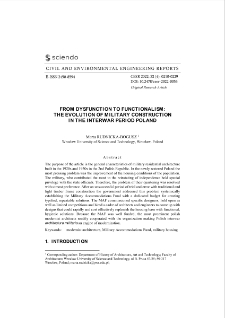Digital Library of Zielona Góra contains 9 272 digital objects
Object
Title: From Dysfunction to Functionalism: the Evolution of Military Construction in The Interwar Period Poland
Contributor:
Group publication title:
Abstract:
The purpose of the article is the general characteristics of military residential architecture built in the 1920s and 1930s in the 2nd Polish Republic. In the newly restored Poland the most pressing problem was the improvement of the housing conditions of the population. The military, who contributed the most to the reinstating of independence held special privilege with the state officials. Therefore, the problem of their quartering was resolved with utmost preference. ; After an unsuccessful period of trial and error with traditional and light timber frame construction the government addressed this problem systemically establishing the Military Accommodations Fund with a dedicated budget for creating typified, repeatable solutions. The MAF commissioned specific designers, held open as well as limited competitions and hired a cadre of architects and engineers to come up with designs that could rapidly and cost effectively replenish the housing base with functional, hygienic solutions. Because the MAF was well funded, the most prominent polish modernist architects readily cooperated with the organization making Polish interwar architectura militaris an engine of modernization.
Description:
tytuł dodatkowy: Prace z Inżynierii Lądowej i Środowiska
Publisher:
Zielona Góra: Oficyna Wydawnicza Uniwersytetu Zielonogórskiego
Format:
Resource Identifier:
DOI:
Pages:
Source:
Civil and Environmental Engineering Reports (CEER), no 32, vol. 4
Language:
License CC BY-NC-ND 3.0:
Rights:
Biblioteka Uniwersytetu Zielonogórskiego
Object collections:
- Repository > Faculties > Construction department, Architecture and Environmental Engineering
- Repository > Types of work > Articles
- Repository > Scientific journals and UZ publishing series > Civil and Environmental Engineering Reports (CEER) > Civil and Environmental Engineering Reports (CEER) (2022)
Last modified:
Jul 6, 2023
In our library since:
Mar 31, 2023
Number of object content hits:
164
All available object's versions:
https://zbc.uz.zgora.pl/repozytorium/publication/80036
Show description in RDF format:
Show description in OAI-PMH format:
| Edition name | Date |
|---|---|
| From Dysfunction to Functionalism: the Evolution of Military Construction in The Interwar Period Poland | Jul 6, 2023 |
Objects Similar
Wagner, Tomasz Nakonieczny, Ryszard Kuczma, Mieczysław - red.
Rudnicka-Bogusz, Marta Kuczyński, Tadeusz - red.

